The first stop on my list was Ijam's Nature Center, which I've been to twice before, because I wanted to see the new Ross Marble Nature Area that they've added behind Mead's Quarry. I know that Knoxville used to have a booming marble industry, but I didn't know that it used to be called the Marble City. That explains why I drive past the Marble City Baptist Church on my way home every day (I thought Marble City was one of the smaller communities that has been absorbed into Knoxville over the years) and why we have so many former marbleworks around town. According to Wikipedia, Tennessee marble declined in popularity after World War II, and there are only six active quarries left that supply demand for it.
Anyway, since I read an article about it in the paper I've been meaning to go out and see the new trail since the new quarry isn't flooded like Mead's is. (I was tol that there's a spring in the bottom of Mead's, which the quarrying released. Mead's will be flooded forever unless the spring dries up.) It's also supposed to have some interesting formations built by the quarry workers, so I headed down the trail:
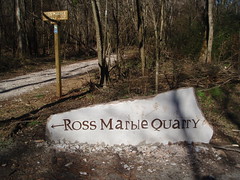
This was a bit of a bad idea, because we had thunderstorms yesterday, and the trail was really muddy. I didn't fall, but I did slip and twist my knee, which really hurt. Before anyone gets worried, I had my phone. Despite the mud, though, I had a great view of the two main features, and got to climb the scary steps:
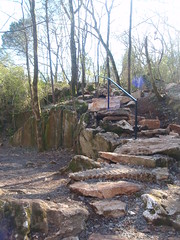
made of marble slabs and chips that make up most the trail.
The main feature is the rock bridge:
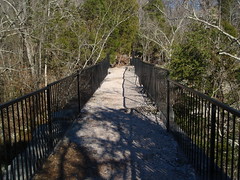
The quarry workers built it to make it easier to get from one side of the quarry to the other, and the Ijam's volunteers added the railings. I hope they had some kind of railings when they used it, because the drop on either side is kind of far:
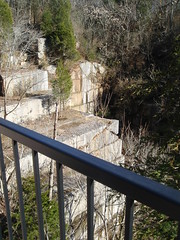
That view gives a good look at the terraces left by quarrying, which is one of the things that makes the site so fascinating. Along the bottom of each terrace, there are rows of holes, as if it has been perforated:
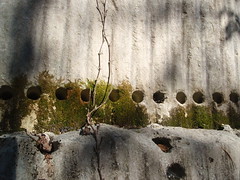
and each edge is grooved as well, like a corrugated tin roof. I'm sure this has something to do with the process by which marble is quarried, but beyond that I have no idea. Maybe they're drill holes? Or they stick dynamite in them? It's weird, because you just walk around the site and look at all these relics of the industry:
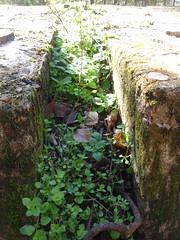
and try to imagine why what's left looks like that and what might have been there.
The other feature, the keyhole, is part of the rock bridge:
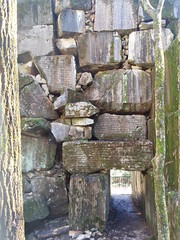
Since the bridge blocked access in one direction while facillitating access in another, the quarry workers built the keyhole in the base of the bridge so that they could cross into the quarry:
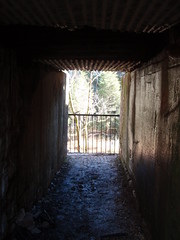
Once I did, though, I decided not to follow the steps down to the bottom, because it looked even muddier than the trail:
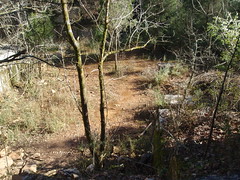
It was still an interesting hike, and when I left the nature center I was already close to my second goal for the day:
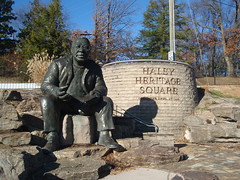
Our twelve foot statue of Alex Haley.
When I first moved to Knoxville, and I heard that our town housed things like the World's Largest Rubik's Cube:
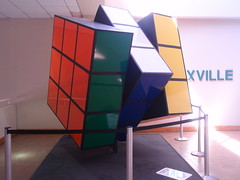
I used to wonder why things like that were here. Now, though, I read that we have a giant statue of Alex Haley and I think, "Oh, OK. I should go take a picture." After all, the world's largest statue of Alex Haley has to end up somewhere, so why not here? I'm sure people with giant balls of twine or The World's Largest Ten Commandments have the same sense of placid acceptance. It turns out, though, that Alex Haley is listed as a famous Knoxvillian, so it sort of make sense that we would have something here to commemorate it, if only to compete with the Dolly Parton statue down the road.
It's actually a pretty nice statue. It's right next to a playground, and it really does look like Alex Haley:
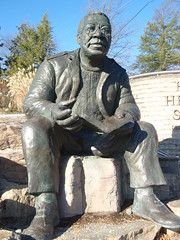
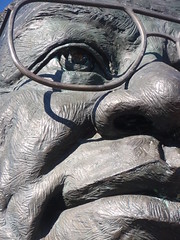
Tina Allen:
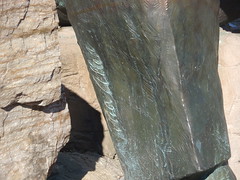
did a really good job, although you do kind of wonder why, if she'd already signed the leg, she needed a huge plaque right on the front of the statue, too:
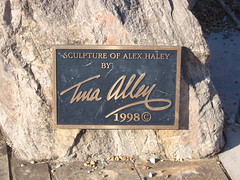
I realize credit should be given where due, but shouldn't the focus of the Alex Haley statue be Alex Haley?
I may never know the answer to that question (or I may, someday, if Tina Allen is a self-Googler) but let's look at what I did learn today:
1) Tennesse marble isn't actually true marble, but is instead crystallized limestone.
2) That Marble City was not a suburb, but was the city of Knoxville itself.
3) Alex Haley is from Knoxville.
4) Christina Hendricks, who plays Joan on "Mad Men", was born in Knoxville.
I look forward to photographing her large bronze statue.
Knoxville isn't bad. I have somewhere cool to show you in Knoxville. I won't tell you all that it offers but I will say that you will need a flashlight even during the day. I took Ben to part of it once but I'm sure he needs to go again. And Kristin and Jeannie if they're up for a short hike too.
ReplyDeleteI want to go!
ReplyDeleteI had no idea that Union Station had a Tennessee marble floor. It's a very nice one: pink herringbone mosaic blocks.
ReplyDelete